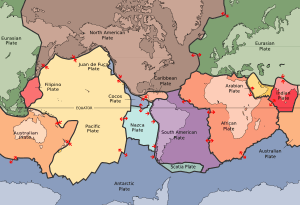Lithosphere facts for kids
The lithosphere is the solid, rocky outer layer of our planet, Earth. Think of it like the hard shell of an egg. It includes the crust, which is the very top layer we live on. It also includes the top part of the mantle, which is the thick layer just below the crust. This part of the mantle is very strong and rigid, meaning it doesn't easily bend or break.
Right below the lithosphere is a softer, hotter layer called the asthenosphere. This part of the mantle is so hot that it can slowly flow, like very thick syrup. The lithosphere sits on top of this flowing layer. It acts like a sturdy lid, helping to control how heat moves from deep inside Earth to the surface.
Contents
What is the Lithosphere Made Of?
The lithosphere is the rigid, outermost shell of Earth. It's made of the crust and the very top part of the upper mantle. The crust is defined by its chemical makeup and the types of rocks it has.
Types of Lithosphere
There are two main types of lithosphere on Earth:
- Oceanic lithosphere: This type is found under the oceans. It's usually about 50 to 100 kilometers (30 to 60 miles) thick.
- Continental lithosphere: This type is found under the continents. It can be much thicker, ranging from about 40 to 200 kilometers (25 to 125 miles) thick. About 40 km of this is the crust itself.
Moving Plates of the Lithosphere
The lithosphere isn't one solid piece. It's broken into huge sections called tectonic plates. These plates are always moving, very slowly, across Earth's surface. This movement causes things like earthquakes and volcanoes.
As oceanic lithosphere gets older and moves away from mid-ocean ridges (underwater mountain ranges where new crust forms), it gets thicker. This happens because it cools down, and the soft asthenosphere below it turns into more rigid lithosphere. Older oceanic lithosphere also becomes denser.
When a continental plate and an oceanic plate meet, the oceanic lithosphere usually sinks beneath the continental plate. This process is called subduction.
New oceanic lithosphere is always being made at mid-ocean ridges. At the same time, old oceanic lithosphere is recycled back into the mantle at subduction zones. Because of this, oceanic lithosphere is much younger than continental lithosphere. The oldest oceanic lithosphere is about 200 million years old. But parts of the continental lithosphere are billions of years old!
How the Lithosphere Behaves
The lithosphere acts like a stiff, rigid shell. When the slow forces that cause tectonic plate movement push on it, it tends to break rather than bend. This is called "brittle failure."
The asthenosphere, the layer below the lithosphere, is much softer because of the heat. It can slowly change shape and flow, which is called "deformation."
The oceanic lithosphere is mostly made of dark, heavy rocks like basalt and gabbro. The continental lithosphere is made of lighter rocks like granite and gneiss.
Related pages
See also
 In Spanish: Litosfera para niños
In Spanish: Litosfera para niños



